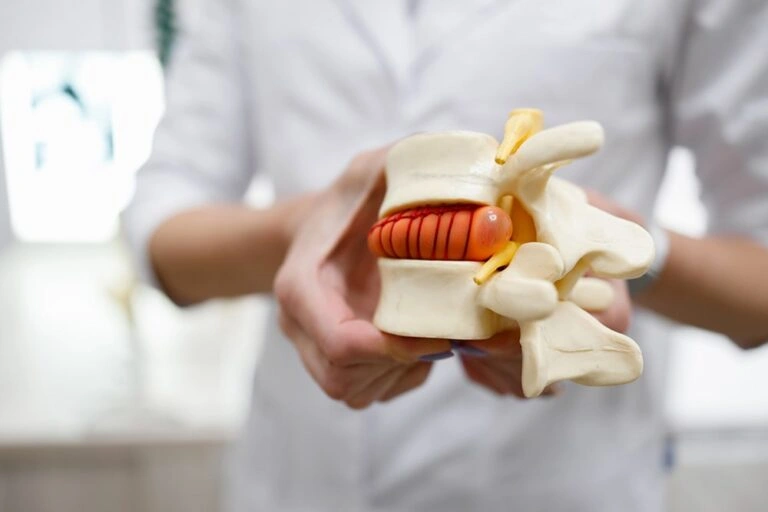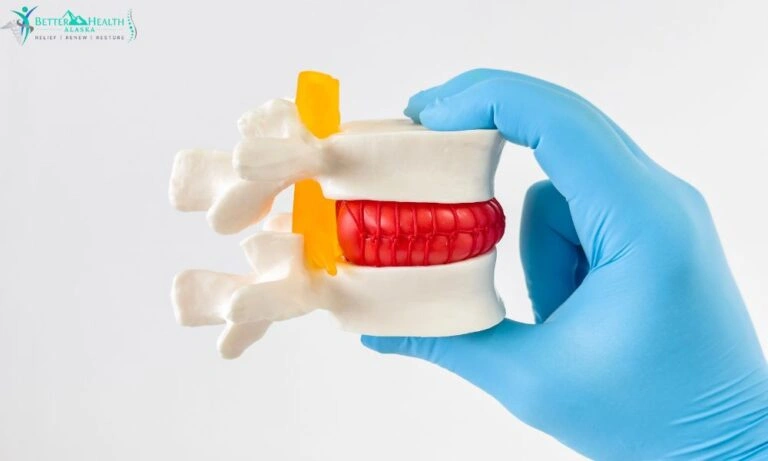One of the main issues with degenerative disc disease (DDD) is that, in the beginning, you might not be suffering many symptoms and may not even know that something is wrong. Pain may come and go, or may develop to a constant level of discomfort over the course of several weeks.
If you suspect that something is wrong with your back or neck, you’re worried you’ve developed disc issues, or you’re suffering from chronic back pain, it would be wise to seek medical advice. There are a number of things you should consider doing or, rather, not doing, as soon as you are diagnosed with degenerative disc disease. These include:
1. Avoid Returning to Normal Activities Too Soon
Don’t jump the gun and return to your normal activities and routine until your chiropractor or doctor tells you you can do so. Many people will start treatment and, as soon as they start to feel better, will rush back into their normal activities immediately. However, degenerative disc disease is a serious condition that needs time to heal.
Even if you are feeling better, there may still be issues in your spinal discs that you just can’t feel. These disc issues will still need to be corrected and healed, otherwise you run the risk of complications returning and creating a whole slew of new problems sometime down the road. You are far better off following through on your entire treatment plan and waiting until your chiropractor or doctor gives you the go-ahead before returning to your usual routine.
- Quick Tip: Stick to your treatment plan and wait for your chiropractor or doctor’s approval before resuming your usual activities.
2. Don’t Rest Too Long
Don’t rest too much or too long. Generally speaking, with degenerative disc disease, a slipped disc, or other back issue, you should only rest about 48 – 72 hours. After that, you need to get up and start moving around. If you don’t, your inactivity may cause further damage to your spine. And you don’t want that!
3. Skip the Heavy Lifting
Avoid doing any heavy lifting. Your chiropractor should give you a recommendation of a weight not to exceed. This may vary from individual to individual, but usually will be in the 5 – 10 pound range.
4. Steer Clear of Sudden Jerking Movements
Avoid activities that involve sudden jerking movements that can further aggravate any spinal issues you may have. This can include activities like certain amusement park rides or even something as simple as dancing.
5. Avoid Sitting on Furniture that Is Abnormally Low
Avoid sitting on bean bag chairs and other types of furniture that are abnormally low to the ground. Even if you get in and get comfortable, you’ll likely have a heck of a time getting out and getting back on your feet. The whole sitting and standing process involved with such furniture may further aggravate your disc issues and impact your spinal health.
6. Avoid Twisting Your Back
Avoid activities and exercises that twist your back or produce unnecessary strain on your spine. This includes straight leg sit-ups, and certain other inappropriate activities that can worsen disc issues like herniated discs and such.
7. Refrain from Jogging
Don’t go running or jogging before your chiropractor or doctor gives you the official okay. While walking is a great exercise for someone with degenerative disc disease, running and/or jogging produces far too many jarring impacts that can aggravate the condition. This may lead to the development of other spinal issues, like herniated discs, for example, that are associated with spinal degeneration.
8. Avoid Dehydration
Managing Degenerative Disc Disease (DDD) effectively requires a keen focus on hydration. Water is essential for:
- Ensuring nutrient exchange within discs
- Preserving disc integrity to prevent herniation and nerve compression
- Potentially reducing pain and enhancing spine function.
- Maintaining disc health and function overall.
For individuals with DDD, the general guideline suggests aiming for approximately 2 liters of water daily, with adjustments made based on personal health factors.
9. Don’t Delay Seeing a Chiropractor
Don’t put off seeing a chiropractor or doctor to get an official diagnosis and proper treatment. The more time that you let your DDD develop and progress on its own, the more likely further complications can arise. Degenerative disc disease progresses fast if not treated.
Complications can include things like herniated discs, general spinal degeneration, and other kinds of spinal ailments. Some of these conditions can cause permanent damage if left untreated. A herniated disc, for example, will often press in onto a nearby nerve. And the nerve can only take so much. After a certain amount of aggravation, permanent nerve damage may result.
- Quick Tip: Book an appointment with a chiropractor as soon as you notice symptoms. Early treatment can greatly improve your life and prevent more problems.
- Case Study: A 66-year-old patient with neck DDD improved her pain and mobility after getting chiropractic care and massage therapy (Source: National Library of Medicine).
10. Shun Poorly Designed Ergonomic Workspaces
For individuals grappling with Degenerative Disc Disease (DDD), crafting a truly effective ergonomic workspace is another way to manage chronic back pain and maintain mobility. Components of an effective ergonomic workspace include:
- Adjustable Chairs with Lumbar Support: Support the spine’s natural curve and minimizes lower back strain.
- Sit-Stand Desks: Facilitates posture variation in order to ease discomfort.
- Appropriate Height and Distance for the Monitor: Ensures a neutral neck position so as to not exacerbate symptoms.
- Keyboard and Mouse Placement: Aids in maintaining a proper arm angle to alleviate shoulder, neck, and back strain.
- Footrests: Offers alignment and pressure relief for those whose feet don’t reach the floor.
- Regular Breaks and Movement: Prevents stiffness and mitigates pain.
Tailoring these elements to your personal needs can significantly enhance your comfort and overall spinal health. It can also serve to round out your pain management strategy over the long term.
- Quick Tip: Consult healthcare and ergonomic professionals when in doubt!
11. Avoid Failing To Consider Mental Health Concerns
Managing Degenerative Disc Disease (DDD) requires dealing with both physical and mental health concerns. The two way influence between chronic pain and mental health can significantly affect treatment outcomes. Things to remember include:
- Shared Neural Pathways: Emotional distress and chronic pain share some neural mechanisms. This means that things that affect one may also affect the other.
- Integrated Therapies: Combining psychological interventions (like Cognitive Behavioral Therapy or mindfulness) with more traditional (physical) pain management techniques may be helpful in some cases.
- Pharmacological Considerations: Some medications benefit both DDD pain and mental health disorders. However, care is required to prevent dependency.
- Psychiatric Services: Incorporating psychiatric care can address both the pain and its psychological impacts.
- Technological Interventions: Web-based programs for chronic pain management offer accessible, effective support for both physical and mental health.
Time and experience have shown that a holistic approach that includes the right combination of non-surgical treatments from a variety of different disciplines is often very effective – particularly when managing DDD alongside mental health concerns.
12. Abstain from Risky, Detrimental, or Inappropriate Social Activities
Maintaining a healthy social life while dealing with Degenerative Disc Disease (DDD) may sometimes require certain adjustments. The goal here is to limit discomfort and foster inclusion. To that end, some effective strategies include:
- Selecting Accessible Venues: Look for locations that minimize physical strain and also provide comfortable seating.
- Strategic Planning: Plan for rest periods and incorporate pain management tactics before and during events.
- Open Communication: Clearly convey what you can and cannot do to the others involved in the event or its planning.
- Utilizing Mobility Aids: If necessary, use canes, lumbar supports, or other aids to provide added comfort during activities.
- Nutrition and Hydration: Make sure to keep hydrated and adequately fed – especially for prolonged engagements.
- Peer Support: Seek out and use a support group to learn about shared experiences and tips on DDD management in social settings.
- Mindfulness Practices: Implement relaxation techniques to control pain and stress.
- Virtual Socialization: Explore online platforms for social interaction so as to bypass physical challenges.
- Consulting Professionals: Seek advice from healthcare experts on how to manage DDD and still maintain an active social life.
With these strategies, individuals with DDD can maintain a fulfilling social life. They can adapt activities to their condition without compromising on their well-being or on their opportunities to socialize.
13. Avoid the Wrong Footwear
Selecting the right footwear is another way to manage Degenerative Disc Disease (DDD). Footwear can affect both spinal alignment and posture. Key items to remember include:
- Supportive Footwear: Choose shoes with sufficient arch support to evenly distribute body weight, thereby easing the spinal load.
- Cushioning: Choose cushioned footwear to diminish shock impact on the spine while walking.
- Proper Fit: Ensure shoes fit well to prevent indirect strain.
- Low to Moderate Heel: High heels exacerbate lumbar lordosis (excessive inward curvature of the spine); a lower heel maintains natural spinal posture.
- Orthotic Inserts: Custom inserts can correct some biomechanical issues. In such cases, they can help manage symptoms.
- Flexibility: Footwear should allow natural foot motion without compromising support.
- Non-Slip Sole: Essential to maintain stability and keep from falling or even just slipping – either of which could aggravate DDD.
Footwear that meets these specifications can aid your overall DDD pain management strategy.
If you avoid each of these 13 items, it will go a long way in helping you heal your degenerative disc disease. At the very least, it will keep you from inadvertently causing further injury or damage to your spine and discs.

Conservative Methods to Help with Degenerative Disc Disease
Now that you’ve seen all the things you should avoid with DDD, you might be wondering about what proactive steps you can take to help heal the condition. There are several conservative avenues for treating degenerative disc disease. But here, we’ll just look at two of the most common and effective: exercise and chiropractic care.
Exercises that Can Help with Degenerative Disc Disease
Although some exercises, like jogging and running, are bad for patients with degenerative disc disease, exercise is still regarded by chiropractors as an effective avenue of treatment for most spinal issues including DDD.
The trick is that you just have to do the right exercises and avoid those that will aggravate the condition. The right exercises, like walking, for example, can improve your overall health and serve to reverse some of the damage DDD can cause. Walking, in conjunction with chiropractic care, can help get a slipped disc back in place. Other good exercises for a patient with degenerative disc disease include:
Rehabilitative Therapy Exercises
These types of exercises have proven themselves to be highly effective and beneficial for patients suffering from DDD. These exercises can target specific areas so as to strengthen the back, neck, and core muscles. This, in turn, will help support the spine and reduce pressure on the spinal column. The end result: is less pain, increased range of motion, and better quality of life.
Yoga
Yoga is one of the best exercise systems out there for correcting musculoskeletal issues like spinal problems and posture. It originates from India where it is heavily intertwined with the culture and religious institutions of Indian society. Practitioners of yoga will take and hold certain body positions that are designed to stretch and strengthen particular muscles and hold such positions for a certain period of time. Not every yoga pose will be suitable for an individual struggling with DDD, but many will. Some yoga poses that are helpful for herniated discs (a common problem with DDD) include:
- Child’s Pose
- Triangle Pose
- Mountain Pose
- Warrior II Pose
- And Corpse Pose
As always, it’s usually a bad idea to take up yoga on your own to deal with a medical condition. You should always seek out a qualified yoga instructor to help you. Find out our top recommended yoga studios in Anchorage, Alaska.
Chiropractic Care and Degenerative Disc Disease
Chiropractic care is another effective way of treating degenerative disc disease. Because chiropractors are experts in the musculoskeletal system, they are highly qualified to diagnose and treat a whole slew of spinal conditions including DDD.
A case study in Science Direct discusses how a 74-year-old man with low back pain and degenerative disc disease was effectively treated with Activator-assisted spinal manipulative therapy. (1) The end result was positive both subjectively and objectively for both pain levels and movement.
Another case study in the National Library of Medicine involved a 66-year-old female client who was suffering from cervical degenerative disc disease (DDD in the neck). (2) Massage therapy was used with positive results: specifically, pain levels decreased while the range of motion and engagement with normal daily activities improved.
Chronic pain management for this condition often involves various approaches, including consultation with a chiropractor for degenerative disc disease, who may employ spinal manipulation and therapeutic exercises to alleviate symptoms and improve mobility.
The particular treatment details of a patient with DDD will be largely determined by the stage that the disease is in. Given that, though, there are a couple of rules of thumb.
First, conservative non-invasive treatments like chiropractic care and physical therapy are usually tried before heavy-hitting procedures like surgery or high-powered painkillers.
Second, chiropractors usually use a well-rounded, holistic, multifaceted approach that incorporates multiple types of treatment. In other words, if you go to a chiropractor you may be prescribed chiropractic care as well as other things like physical therapy, chiropractic massage, and even dietary/supplement suggestions.
All such treatments are used in tandem. In our experience, chiropractic care used in conjunction with physical therapy (and other therapies) is far more effective than using either type of treatment on its own.
See a Highly Recommended Chiropractor
As you can see, if you suffer from degenerative disc disease, you are not simply at the mercy of your illness. You can take an active role in your health by avoiding the things mentioned above, and seeking out chiropractic care.
To help Alaskans suffering from DDD, among other things, we offer chiropractic adjustments included in our Alaska Back Pain Protocol. We’ve seen remarkable success over the years.









